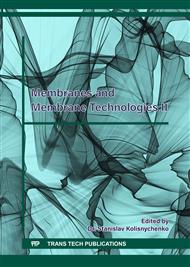[1]
L.N. Fesenko, I.V. Pchelnikov, S.I. Ignatenko, Economic efficiency estimation of obtaining sodium hypochlorite by electrolysis of sea water. Book of reports from research-to-practice conference dedicated to the memory of RAS academician S.V. Yakovlev, Moscow State University of Civil Engineering, Moscow: MGSU, (2012).
Google Scholar
[2]
S.V. Kudryavtsev, Improvement of technological parameters of units for obtaining electrolytic sodium hypochlorite for water disinfection, Novocherkassk, (2009).
Google Scholar
[3]
L.N. Fesenko, V.V. Denisov, A.Yu. Skryabin, Water disinfectant – sodium hypochlorite: manufacture, application, economy and ecology (Edited by Professor V.V. Denisov), Rostov-on-Don: Publishing House SKNTS VSH YUFU, (2012).
Google Scholar
[4]
G.L. Medrish, A.A. Teisheva, D.L. Basin, The treatment of natural and sewage waters by means of electrolysis, Moscow: Stroyizdat Publishing House, (1982).
Google Scholar
[5]
L.N. Fesenko, A.Y. Scryabin, S.I. Ignatenko, Experience in the use of sodium hypochlorite in water disinfection at treatment facilities of the Central Water Pipe, Rostov-on-Don, Water supply and san. equipment. 9 (2009) 46-51.
Google Scholar
[6]
A.K. Kinebas, E.D. Nefyodova, A.V. Bekrenev, Disinfection of water with low-concentration sodium hypochlorite at watersupply plants in St. Petersburg, Water supply and san. equipment. 3 (2010) 24-29.
Google Scholar
[7]
B.L. Vider, A.P. Gorshenin, G.E. Itkin, A new way of obtaining electrolytic hypochlorite and its application, Water supply and san. equipment, 1 (2005) 26-27.
Google Scholar
[8]
L.N. Fesenko, S.I. Ignatenko, A.Y. Scryabin, I.V. Pchelnikov, Ways of solution of ecologically compatible and non-waste production of electrolytic sodium hypochlorite for disinfection of drinking water, Water purification. 3 (2014) 9-16.
Google Scholar
[9]
L.N. Fesenko, A.Y. Skryabin, S.I. Ignatenko, R.V. Fedotov, Ensuring the waste-free and environmentally friendly production of sodium hypochlorite using Chlorefs, units, Water supply and san. equipment. 8 (2011) 25-29.
Google Scholar
[10]
G.E. Itkin, M.S. Goukhberg, Y.A. Trukhin, New installations for the production of hypochlorite, Water supply and sanitary equipment. 10 (1998) 18.
Google Scholar
[11]
L.A. Kulsky, O.S. Grebenyuk, Electrochemistry in water purification processes, Kiev: The Technique, (1987).
Google Scholar
[12]
L.N. Fesenko, S.I. Ignatenko, I.V. Pchelnikov, Improvement of the technology for production of disinfecting reagent - sodium hypochlorite by electrolysis of sea water, Water supply and san. equipment. 1 (2015) 11-21.
Google Scholar
[13]
L.N. Fesenko, S.I. Ignatenko, I.V. Pchelnikov, Comparative analysis of methods for obtaining low-concentration sodium hypochlorite by electrolysis of sea water and sodium chloride solution. // Scientific potential of regions for modernization service: interuniversity scientific article/Astrakhan Engineering university. Astrakhan: AISI, 3(6), 2 (2013).
Google Scholar
[14]
B.F. Lyamayev, Disinfection of natural and waste waters with chlorine reagents obtained directly at the place of consumption, Chemistry and Technology of Water. 16(6) (1994) 653-660.
Google Scholar
[15]
V.G. Ivanov, Disinfection of drinking and waste waters by products of electrochemical activation, Water supply and sanitary equipment. 10 (2000) 26-28.
Google Scholar
[16]
D.L. Basin, Study of technology and development of equipment for drinking water disinfection by direct electrolysis, Moscow, (1978).
Google Scholar
[17]
O.I. Dryi, A.L. Fesenko, A.I. Vergunov, Production of sodium hypochlorite from solutions of various nature, Book of reports from research-to-practice conference dedicated to the memory of RAS academician S.V. Yakovlev, Moscow: MSGU, (2012).
Google Scholar
[18]
A.G. Pervov, A.P. Andrianov, T.P. Gorbunova, E.B. Yurchevsky, Technology of utilization of concentrate from reverse osmosis units in water treatment systems, Water supply and san. equipment, 8 (2012).
Google Scholar
[19]
A.G. Pervov, A.P. Andrianov, T.P. Gorbunova, Development of membrane technologies with reduced water consumption for own needs, Water supply and san. equipment, 6 (2010).
Google Scholar
[20]
L.N. Fesenko, S.I. Ignatenko, I.V. Pchelnikov, Fields of application of sodium hypochlorite obtained by electrolysis of sea water, South-Russian State. Tech. University (NPI). Novocherkassk: Lik, (2012) 93-98.
Google Scholar
[21]
P.N. Vykhristyuk, Complex system of protection against corrosion and fouling, Shipbuilding. 5 (2001) 64-65.
Google Scholar
[22]
E.S. Razumovsky, G.L. Medrish, V.A. Kazaryan, Purification and disinfection of sewage in small settlements, Moscow: Stroiizdat, (1986).
Google Scholar
[23]
SanRaN 2.1.4.1074-01. Drinking water. Hygienic requirements for water quality of centralized drinking water supply systems. Quality control. Moscow, (2001).
Google Scholar



